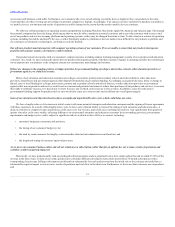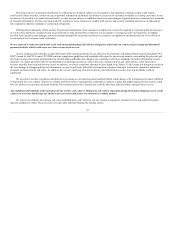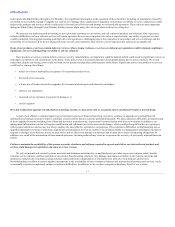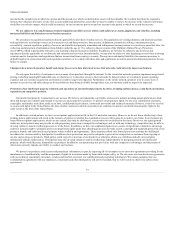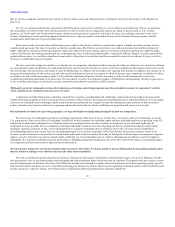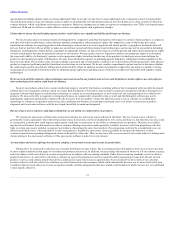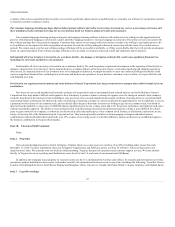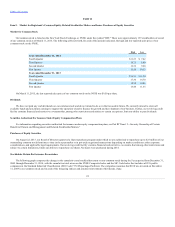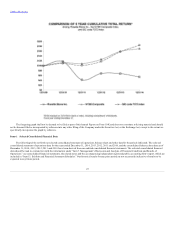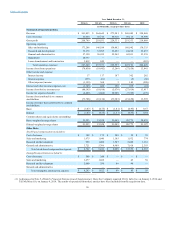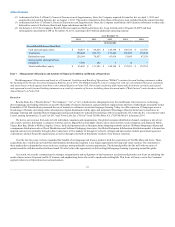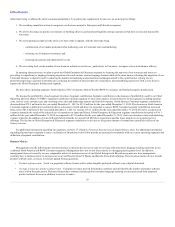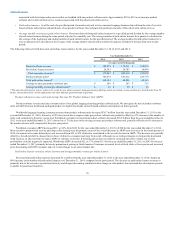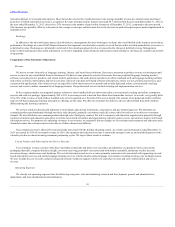Rosetta Stone 2014 Annual Report Download - page 22
Download and view the complete annual report
Please find page 22 of the 2014 Rosetta Stone annual report below. You can navigate through the pages in the report by either clicking on the pages listed below, or by using the keyword search tool below to find specific information within the annual report.
Table of Contents
that we will have adequate remedies for any breach, or that our trade secrets and other proprietary information will not be disclosed or will otherwise be
protected.
We rely on contractual and license agreements with third parties in connection with their use of our products and technology. There is no guarantee
that such parties will abide by the terms of such agreements or that we will be able to adequately enforce our rights, in part because we rely, in many
instances, on "click-wrap" and "shrink-wrap" licenses, which are not negotiated or signed by individual licensees. Accordingly, some provisions of our
licenses, including provisions protecting against unauthorized use, copying, transfer, resale and disclosure of the licensed software program, could be
unenforceable under the laws of several jurisdictions.
Protection of trade secret and other intellectual property rights in the places in which we operate and compete is highly uncertain and may involve
complex legal questions. The laws of countries in which we operate may afford little or no protection to our trade secrets and other intellectual property
rights. Although we defend our intellectual property rights and combat unlicensed copying and use of software and intellectual property rights through a
variety of techniques, preventing unauthorized use or infringement of our intellectual property rights is inherently difficult. Despite our enforcement efforts
against software piracy, we could lose significant revenue due to illegal use of our software and from counterfeit copies of our software. If piracy activities
increase, it could further harm our business.
We also expect that competitors might try to illegally use our proprietary information and develop products that are similar to ours, which may infringe
on our proprietary rights. In addition, we could potentially lose trade secret protection for our source code if any unauthorized disclosure of such code occurs.
The loss of trade secret protection could make it easier for third parties to compete with our products by copying functionality. In addition, any changes in, or
unexpected interpretations of, the trade secret and other intellectual property laws in any country in which we operate may compromise our ability to enforce
our trade secret and intellectual property rights. Costly and time-consuming litigation could be necessary to enforce and determine the scope of our
confidential information and trade secret protection. If we are unable to protect our proprietary rights or if third parties independently develop or gain access
to our or similar technologies, our business, revenue, reputation and competitive position could be harmed.
Third-party use of our trademarks as keywords in internet search engine advertising programs may direct potential customers to competitors' websites,
which could harm our reputation and cause us to lose sales.
Competitors and other third parties, including counterfeiters, purchase our trademarks and confusingly similar terms as keywords in internet search
engine advertising programs in order to divert potential customers to their websites. Preventing such unauthorized use is inherently difficult. If we are unable
to protect our trademarks and confusingly similar terms from such unauthorized use, competitors and other third parties may continue to drive potential
online customers away from our websites to competing and unauthorized websites, which could harm our reputation and cause us to lose sales.
Our trademarks are limited in scope and geographic coverage and might not significantly distinguish us from our competition.
We own several U.S. trademark registrations, including registrations of the and trademarks, as well as
U.S. registrations of the color yellow as a trademark. In addition, we hold common law trademark rights and have trademark applications pending in the U.S.
and abroad for additional trademarks. Even if federal registrations and registrations in other countries are granted to us, our trademark rights may be
challenged. It is also possible that our competitors will adopt trademarks similar to ours, thus impeding our ability to build brand identity and possibly
leading to customer confusion. In fact, various third parties have registered trademarks that are similar to ours in the U.S. and overseas. Furthermore,
notwithstanding the fact that we may have secured trademark rights for our various trademarks in the United States and in some countries where we do
business, in other countries we may not have secured similar rights and, in those countries there may be third parties who have prior use and prior or superior
rights to our own. That prior use, prior or superior right could limit use of our trademarks and we could be challenged in our efforts to use the Company’s
trademarks. We could incur substantial costs in prosecuting or defending trademark infringement suits. If we fail to effectively enforce our trademark rights,
our competitive position and brand recognition may be diminished.
We must monitor and protect our internet domain names to preserve their value. We may be unable to prevent third parties from acquiring domain names
that are similar to, infringe on or otherwise decrease the value of our trademarks.
We own several domain names related to our business. Third parties may acquire substantially similar domain names or Top Level Domains ("TLDs")
that decrease the value of our domain names and trademarks and other proprietary rights which may hurt our business. Third parties also may acquire country
specific domain names in the form of Country Code TLDs that include our trademarks or similar terms and which prevent us from operating country specific
websites from which customers can view our products and engage in transactions with us. Moreover, the regulation of domain names in the United States and
foreign countries is subject to change. Governing bodies could appoint additional domain name registrars, modify the
20






